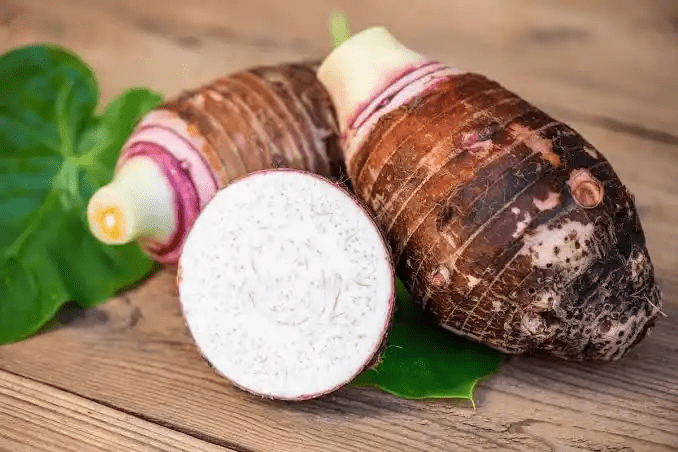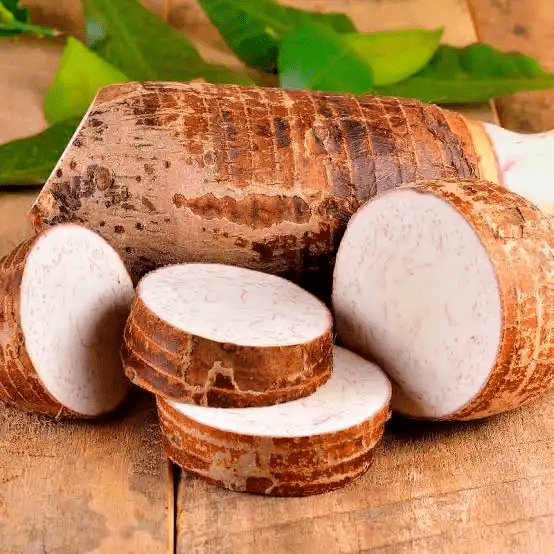Taro (Colocasia esculenta) is a versatile and nutritious tuber that has been a staple in diets across various cultures for centuries. Beyond its culinary uses, taro boasts an array of medicinal health benefits, making it a valuable addition to a well-rounded and health-conscious lifestyle.
One of the primary health benefits of taro is its rich nutritional profile. It is a good source of essential nutrients, including vitamins, minerals, and dietary fiber.
Taro contains significant amounts of vitamin C, which is known for its immune-boosting properties. Additionally, it provides essential minerals such as potassium, magnesium, and iron, contributing to the overall well-being of the body.
Taro is renowned for its potential to support digestive health. The high dietary fiber content in taro aids in promoting regular bowel movements and preventing constipation.
Fiber also plays a crucial role in maintaining a healthy gut microbiome, supporting the growth of beneficial bacteria that contribute to optimal digestive function.
Furthermore, taro has been associated with improved heart health. The potassium content in taro helps regulate blood pressure by balancing the effects of sodium in the body.
Maintaining a healthy blood pressure is essential for reducing the risk of cardiovascular diseases, such as heart attacks and strokes. The fiber in taro also contributes to heart health by helping to lower cholesterol levels, thus supporting a healthy cardiovascular system.
Taro’s anti-inflammatory properties make it a valuable asset in managing inflammatory conditions. Chronic inflammation is linked to various health issues, including arthritis and other autoimmune disorders.
The antioxidants present in taro help neutralize free radicals, reducing oxidative stress and inflammation within the body.
In traditional medicine, taro has been utilized to address respiratory issues. Its expectorant properties may help alleviate symptoms associated with respiratory conditions such as coughs and bronchitis. Consuming taro may assist in clearing the respiratory passages and promoting easier breathing.
Moreover, taro is considered beneficial for individuals managing diabetes. Its low glycemic index helps regulate blood sugar levels, making it a suitable option for those looking to control their glucose levels.
The fiber in taro also plays a role in stabilizing blood sugar by slowing down the absorption of sugar, preventing sudden spikes.
Incorporating taro into the diet may also contribute to improved skin health. The presence of vitamins and antioxidants supports the skin’s natural regeneration process, promoting a healthy and radiant complexion.
Additionally, taro’s anti-inflammatory properties may benefit individuals with skin conditions such as eczema or psoriasis.
It’s important to note that while taro offers numerous health benefits, moderation is key. Excessive consumption may lead to an intake of unwanted calories and carbohydrates. As with any food, it is advisable to enjoy taro as part of a balanced and varied diet.
Taro is not only a delicious and versatile ingredient in various cuisines but also a powerhouse of medicinal health benefits. From supporting digestive health to aiding in the management of chronic conditions, taro stands out as a nutrient-dense tuber with a lot to offer for overall well-being.
Integrating taro into your diet can be a flavorful and health-conscious choice, providing both culinary delight and potential health advantages.
The Botanical Description of Taro
1. Botanical Identity: Scientifically known as Colocasia esculenta, this perennial herbaceous plant belongs to the Araceae family. Renowned for its starchy corms, it is a staple in many tropical regions worldwide.
2. Foliage and Growth Habit: Showcasing large, heart-shaped leaves supported by sturdy petioles, the growth habit is characterized by a clumping pattern, forming dense foliage that contributes to its visual appeal.
3. Corm Structure: The underground storage organ is the primary edible part, a bulbous structure similar in appearance to a potato, with a rough, brown outer layer covering the starchy, white or purple flesh inside.
4. Flowering and Reproduction: Taro plants produce an inflorescence known as a “spadix,” surrounded by a leaf-like bract known as a “spathe.” The flowers are typically inconspicuous, with the plant relying more on vegetative reproduction through corms and cormels.
The Geographic Distribution of Taro
1. Origin and Spread: Believed to have originated in Southeast Asia, it has been cultivated for thousands of years, spreading to various tropical and subtropical regions globally.
2. Tropical Affinity: Thriving in warm, tropical climates with high rainfall, it is commonly cultivated in countries such as India, China, Nigeria, and several Pacific islands.
3. Global Cultivation: Due to its versatility and adaptability, it is now cultivated in both tropical and subtropical regions worldwide. Its cultivation extends to South America, the Caribbean, Africa, and even parts of the southern United States.
4. Cultural Significance: Holding cultural significance in many societies, it is considered a traditional staple. Its widespread cultivation and use in various cuisines contribute to its importance as a global food source.
The Chemical Composition of Taro
1. Macronutrient Content: A rich source of macronutrients, particularly carbohydrates, contributes to its starchy nature. The corms also contain a moderate amount of dietary fiber, aiding in digestion.
2. Micronutrients: A good source of essential micronutrients, including vitamins and minerals. It provides significant amounts of vitamin C, potassium, and folate, contributing to overall health.
3. Antioxidant Compounds: Contains various antioxidant compounds, such as flavonoids and polyphenols, which play a role in neutralizing free radicals in the body. These antioxidants contribute to potential health benefits.
4. Phytochemicals: Contains phytochemicals with potential health-promoting properties. Some studies suggest anti-inflammatory and antimicrobial effects, although more research is needed to fully understand the extent of these benefits.
5. Oxalate Content: Worth noting is its relatively high oxalate content, which may be a concern for individuals prone to kidney stones. Cooking methods like boiling or steaming can help reduce oxalate levels.
The botanical description, geographic distribution, and chemical composition highlight its significance as a versatile and nutritious plant. From its distinctive appearance to its widespread cultivation, taro continues to be a vital component of global agriculture and cuisine.
Read Also: 17 Medicinal Health Benefits Of Polygonum aviculare (Common Knotgrass)
The Medicinal Health Benefits Of Taro (Colocasia esculenta)

1. Anti-Inflammatory Properties: Taro possesses anti-inflammatory effects, making it valuable for managing conditions characterized by inflammation.
2. Digestive Health: The plant’s fiber content contributes to digestive health, promoting regular bowel movements and preventing constipation.
3. Cardiovascular Support: Taro contains nutrients that support heart health, including potassium, which helps regulate blood pressure.
4. Respiratory Health: Certain compounds in taro may contribute to respiratory health, potentially aiding in managing respiratory conditions.
5. Antioxidant Action: Taro is rich in antioxidants, which help combat oxidative stress in the body, supporting overall health.
6. Wound Healing: The plant’s medicinal properties may contribute to wound healing, promoting faster recovery.
7. Immune System Boost: Compounds in taro may enhance the immune system, assisting the body in defending against infections.
8. Anti-Cancer Potential: Some studies suggest that taro may have anti-cancer properties, although further research is needed to confirm this.
9. Arthritis Relief: Taro’s anti-inflammatory effects may provide relief for individuals with arthritis, reducing inflammation and pain.
10. Stress Reduction: Compounds in taro may have calming effects, contributing to stress reduction and improved mental well-being.
11. Skin Health: Taro’s antioxidant properties may benefit skin health, potentially slowing down the aging process and promoting a healthy complexion.
12. Diabetes Management: Taro may play a role in managing diabetes by helping regulate blood sugar levels.
13. Anti-Microbial Action: The plant’s properties may have antimicrobial effects, helping combat various types of pathogens.
14. Muscle Cramp Relief: Taro’s potassium content may help prevent muscle cramps, contributing to better muscle health.
15. Cognitive Function: Some compounds in taro may have neuroprotective effects, potentially supporting cognitive function.
16. Menstrual Health: Taro’s properties may contribute to menstrual health, alleviating discomfort associated with menstrual cycles.
Methods of Usage to Achieve the Provided Health Benefits Of Taro
1. Culinary Consumption: Incorporating taro into regular meals, whether boiled, baked, or as part of stews, allows for the consumption of its beneficial compounds.
2. Taro Supplements: Taro supplements, available in various forms, offer a convenient way to harness its medicinal benefits.
3. Poultices and Topical Applications: For wound healing and skin health, creating poultices or applying taro extracts topically can be effective.
4. Taro Infusions and Teas: Brewing infusions or teas from taro leaves may contribute to respiratory health, stress reduction, and immune system support.
5. Tinctures: Tinctures provide a concentrated form of taro extracts for easy ingestion, offering benefits for internal health.
6. Taro Capsules: Taro in capsule form provides a measured dosage of its medicinal properties, facilitating consistent consumption.
Side Effects Of Using Taro Medicinal Plant
1. Allergic Reactions: Individuals with allergies to taro or related plants may experience allergic reactions, emphasizing the importance of cautious use.
2. Oxalate Content Concerns: Taro contains oxalates, and excessive consumption may contribute to kidney stone formation. Moderation is advised.
3. Gastrointestinal Discomfort: Some individuals may experience gastrointestinal issues, such as nausea or stomach upset, with excessive taro consumption.
4. Potassium Sensitivity: People with potassium sensitivity or kidney problems should monitor their taro intake, as excessive potassium may pose risks.
5. Skin Irritation: Direct contact with taro plants, especially the latex, can cause skin irritation in sensitive individuals.
6. Pregnancy and Breastfeeding: Limited information is available, so pregnant or breastfeeding individuals should consult with healthcare professionals before using taro medicinally.
7. Blood Sugar Levels: Individuals with diabetes should monitor their blood sugar levels, as taro may affect glucose levels.
8. Interactions with Medications: Taro may interact with certain medications, and consultation with healthcare professionals is advised for those on medication regimens.
In summary, while taro offers numerous medicinal health benefits, cautious and informed usage is crucial to mitigate potential side effects. Always consult with healthcare professionals before incorporating it into your health regimen.
Read Also: List of Diseases Ruminant Animals (Livestock) Get from Feeds and Water
The Scientific Research and Studies of Taro

1. Nutritional Composition: Numerous scientific studies delve into the nutritional profile of this plant, exploring its macro and micronutrient content, highlighting its potential as a valuable dietary component.
2. Medicinal Properties: Research investigates the medicinal aspects of taro, focusing on its anti-inflammatory, antioxidant, and potential anti-cancer effects, contributing to the understanding of its therapeutic value.
3. Impact on Chronic Diseases: Scientific studies explore the plant’s impact on chronic diseases such as diabetes and cardiovascular conditions, shedding light on its role in managing and preventing these health issues.
4. Cultivation Techniques: Agricultural studies looked into optimizing taro cultivation techniques, aiming to enhance yield, quality, and resistance to pests and diseases.
The Safety Precautions and Recommendations In Using Taro Medicinal Plant
1. Allergic Reactions: Prioritize patch tests, especially for topical applications, to identify and avoid potential allergic reactions.
2. Oxalate Sensitivity: Individuals prone to kidney stones or with oxalate sensitivity should monitor consumption, as it contains oxalates that may contribute to stone formation.
3. Moderation in Consumption: Exercise moderation in consumption, especially for individuals with underlying health conditions, to prevent potential adverse effects.
4. Consultation with Healthcare Professionals: Seek guidance from healthcare professionals, particularly for pregnant or breastfeeding individuals and those with existing health conditions, to ensure safe usage.
5. Skin Contact Precautions: When handling the plant, take precautions to avoid direct skin contact, as the latex can cause irritation in sensitive individuals.
6. Blood Sugar Monitoring: Individuals with diabetes should monitor their blood sugar levels when incorporating it into their diet, as it may influence glucose levels.
7. Potential Drug Interactions: Be cautious about potential interactions with medications, and consult with healthcare professionals if you are on a medication regimen.
FAQs About Taro Medicinal Plant
1. Is it safe for regular consumption?
Yes, it is safe for regular consumption when incorporated into a balanced diet. However, individuals with specific health conditions should consult with healthcare professionals.
2. Can it be used topically for skin issues?
Yes, extracts can be used topically for wound healing and certain skin conditions. Perform a patch test to check for any allergic reactions.
3. Are there any side effects associated with consumption?
Excessive consumption may lead to gastrointestinal discomfort and, in sensitive individuals, allergic reactions or skin irritation.
4. Can pregnant or breastfeeding individuals use it medicinally?
Limited information is available, and it is advisable for pregnant or breastfeeding individuals to consult with healthcare professionals before using it medicinally.
5. Does it interact with medications?
It may interact with certain medications, so it’s crucial to consult with healthcare professionals, especially if you are on medication regimens.
6. How can it be safely incorporated into the diet?
It can be safely incorporated by cooking it through methods like boiling, baking, or as part of various dishes. Moderation is key.
7. Does it have any impact on blood sugar levels?
Individuals with diabetes should monitor their blood sugar levels when consuming it, as it may affect glucose levels.
8. Can it be grown at home?
Yes, it can be grown at home with proper care. Understanding its cultivation requirements is essential for a successful harvest.
9. Is it suitable for individuals with kidney stones?
Individuals prone to kidney stones should moderate their intake due to its oxalate content, which may contribute to stone formation.
10. How can allergic reactions be avoided?
Conducting patch tests before using it topically can help identify and avoid potential allergic reactions.
11. Are there specific varieties with distinct benefits?
Various varieties exist, each with unique flavors and textures. While nutritional content may vary slightly, all varieties offer health benefits.
12. Can it be included in a weight-loss diet?
Yes, it can be part of a balanced weight-loss diet when consumed in moderation, thanks to its nutritional profile and fiber content.
13. Can it be used as a natural remedy for stress?
Compounds in it may have calming effects, contributing to stress reduction. However, it should not replace professional stress management strategies.
14. Is it suitable for individuals with heart conditions?
Its potassium content supports heart health, but individuals with specific heart conditions should consult with healthcare professionals regarding its consumption.
15. Can it be consumed raw?
While it is often cooked before consumption, some people enjoy it raw in certain dishes. However, cooking is recommended to neutralize potentially harmful compounds.
16. How can it be stored to maintain freshness?
Store it in a cool, dark place with good ventilation, away from direct sunlight. This helps prevent sprouting and extends its freshness.
17. Are there any cultural practices associated with its consumption?
It holds cultural significance in various societies. Understanding traditional recipes and practices enhances the culinary and cultural experience of its consumption.
In conclusion, these FAQs provide valuable information for individuals considering the medicinal use of this plant, addressing safety, consumption methods, and potential side effects. Always consult with healthcare professionals for personalized guidance.
Read Also: Anatomy of Fishes: Female Fish and their Reproductive Strategies

